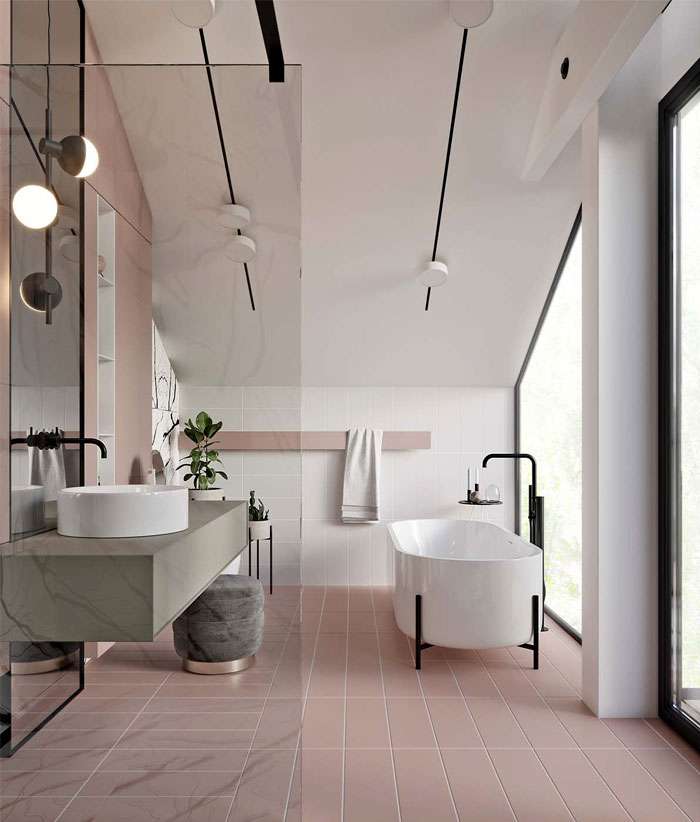The year 2020 brought with it a wave of innovative and stylish bathroom designs, pushing the boundaries of functionality and aesthetics. Forget sterile, purely utilitarian spaces; modern bathrooms transformed into personal sanctuaries, reflecting individual tastes and embracing cutting-edge technology. From minimalist retreats to opulent spa-like experiences, these designs prioritized comfort, sustainability, and personalization. Exploring the best of modern bathroom designs 2020 reveals a commitment to creating spaces that are both beautiful and practical, and that’s why we will discover the main trends of modern bathroom designs 2020.
Key Trends Shaping Bathroom Design
Several key trends defined the landscape of bathroom design in 2020. These trends moved away from traditional notions and embraced new materials, technologies, and design philosophies. Let’s take a look at some of the most influential factors:
- Minimalism and Clean Lines: A focus on simplicity and uncluttered spaces, emphasizing functionality and a sense of calm.
- Natural Materials: Incorporating wood, stone, and other natural elements to bring warmth and texture into the bathroom.
- Smart Technology: Integrating features like smart toilets, digital showers, and voice-controlled lighting for enhanced convenience.
- Statement Lighting: Using bold and artistic lighting fixtures to create focal points and add personality to the space.
- Bold Colors: Moving away from strictly neutral palettes and embracing bolder hues, often used as accent colors.
Exploring Specific Design Elements
Beyond the overarching trends, specific design elements played a crucial role in shaping the look and feel of modern bathrooms in 2020:
Vanity Designs
Vanities became more than just functional storage; they became design statements. Floating vanities, offering a sleek and modern look, were particularly popular. Materials ranged from reclaimed wood to high-gloss lacquers, allowing for a wide range of aesthetic possibilities.
Shower Enclosures
Frameless glass shower enclosures continued to dominate, creating a sense of openness and maximizing natural light. Walk-in showers, often incorporating multiple showerheads and body sprays, provided a luxurious and spa-like experience.
Bathtubs
While showers were often prioritized for their practicality, freestanding bathtubs remained a sought-after feature, especially in larger bathrooms. Sculptural designs and natural materials like stone or wood added a touch of elegance and sophistication.
Comparison: Traditional vs. Modern Bathroom Design
| Feature | Traditional Bathroom | Modern Bathroom (2020) |
|---|---|---|
| Color Palette | Neutral, often pastel | More varied, including bold colors and accents |
| Materials | Ceramic tile, chrome fixtures | Natural stone, wood, matte finishes |
| Technology | Limited or no technology | Smart toilets, digital showers, voice control |
| Overall Style | Ornate, detailed, often cluttered | Minimalist, clean lines, uncluttered |
Ultimately, the modern bathroom designs 2020 were all about creating personalized spaces that reflected individual lifestyles and preferences. By embracing innovation, sustainability, and a focus on comfort, these designs redefined the bathroom as a true sanctuary within the home.
Looking forward, the principles established in 2020 continue to influence contemporary bathroom aesthetics. The emphasis on personalization, sustainability, and technological integration remains strong, albeit with evolving interpretations and new innovations. Consider these continuing trends:
EVOLVING TRENDS: BEYOND 2020
The foundation laid in 2020 has given rise to even more sophisticated and nuanced approaches to bathroom design. Here are some of the ways these trends are evolving:
– Biophilic Design: An increased focus on connecting with nature through the use of plants, natural light, and organic materials. This goes beyond simply adding a potted plant; it’s about creating a holistic environment that promotes well-being.
– Sustainability as Standard: Eco-friendly fixtures, water-saving technologies, and sustainably sourced materials are no longer a niche trend but are becoming expected features in modern bathrooms.
– Color Psychology: A deeper understanding of how colors impact mood and well-being is influencing color choices. Bathrooms are being designed to evoke specific emotions, such as tranquility, energy, or creativity.
– Texture and Tactility: Moving beyond visual aesthetics, designers are focusing on the tactile experience of the bathroom. Materials with interesting textures, such as rough-hewn stone or soft, plush towels, are being incorporated to engage the senses.
SMART HOME INTEGRATION
The integration of smart home technology continues to advance, offering even greater control and customization in the bathroom. Consider these advancements:
– Personalized Shower Experiences: Showers that automatically adjust temperature, pressure, and spray patterns based on individual preferences.
– Smart Mirrors with Integrated Displays: Mirrors that provide weather updates, news headlines, and access to entertainment, all while you get ready.
– Voice-Controlled Ambiance: The ability to adjust lighting, temperature, and music with simple voice commands, creating a truly personalized and relaxing atmosphere.
SMALL BATHROOM SOLUTIONS
While luxurious, spa-like bathrooms are desirable, many homes have limited space. Designers are becoming increasingly adept at maximizing functionality and style in smaller bathrooms. Here are some key strategies:
– Wall-Mounted Fixtures: Floating vanities and toilets save floor space and create a sense of openness.
– Corner Showers: Utilizing corners efficiently maximizes the usable area.
– Mirrored Cabinets: Combining storage and reflection creates the illusion of a larger space.
– Vertical Storage: Tall, narrow cabinets and shelves provide ample storage without taking up valuable floor space.
The journey of bathroom design is an ongoing evolution. The innovative approaches of 2020 laid the groundwork for a future where bathrooms are not just functional spaces, but true reflections of personal style and technological advancement. By embracing sustainability, personalization, and cutting-edge technology, designers continue to push the boundaries of what’s possible, creating bathrooms that are both beautiful and beneficial to our well-being.


